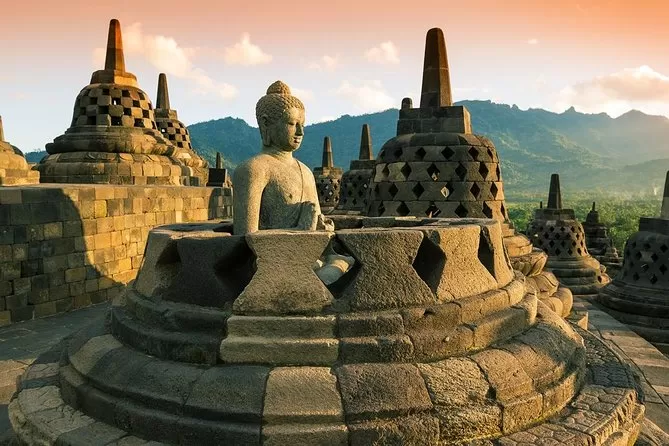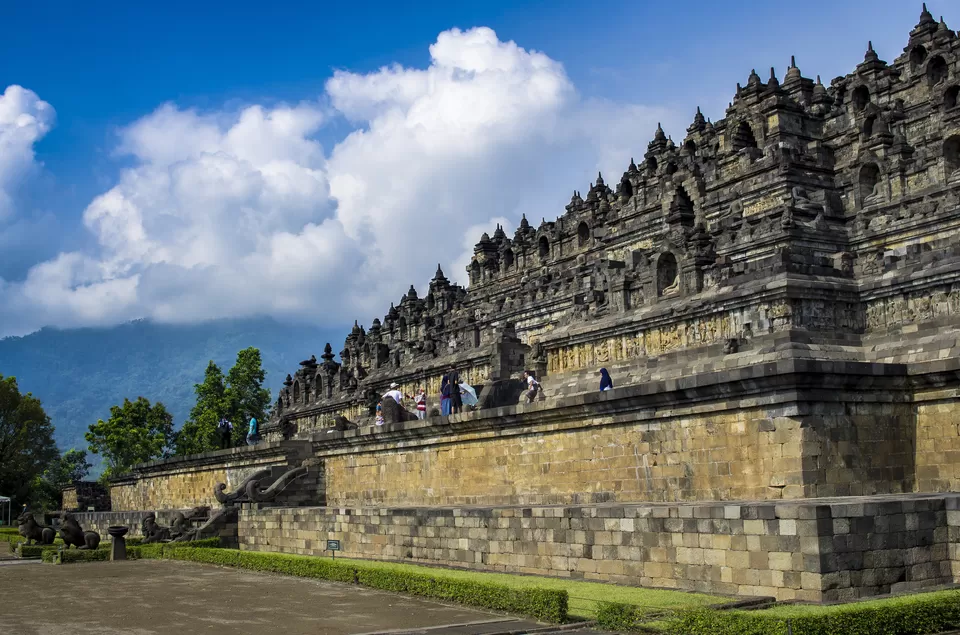Borobudur is one of the most impressive and awe-inspiring sights in the world. Located in Central Java, Indonesia, this colossal temple complex is the largest Buddhist monument ever built, and a testament to the skill and devotion of its creators. Borobudur is not only a masterpiece of art and engineering, but also a sacred place of pilgrimage and meditation for millions of Buddhists and travelers alike.
If you are planning a trip to Indonesia, you should not miss the opportunity to visit Borobudur and witness its beauty and majesty for yourself. In this article, we will provide you with everything you need to know about visiting Borobudur, from its fascinating history and stunning architecture to its best views and practical tips. Whether you are a solo traveler, a couple, a family, or a group, you will find something to suit your interests and preferences at Borobudur.
Why Visit Borobudur
Borobudur is not just a temple, but a monument of world heritage and culture. Here are some of the reasons why you should visit Borobudur:
History:
Borobudur was built in the 9th century, during the reign of the Sailendra dynasty, which ruled over Java and Sumatra. The temple was designed as a mandala, a symbolic representation of the Buddhist cosmology, and consists of nine platforms, six square and three circular, topped by a central dome. The temple is decorated with over 2,600 relief panels and 504 Buddha statues, depicting scenes from the life of the Buddha and his teachings. Borobudur was abandoned in the 14th century, after the rise of Islam in Java, and was rediscovered in the 19th century by the British explorer Sir Thomas Stamford Raffles. Since then, Borobudur has undergone several restoration and conservation efforts, and was declared a UNESCO World Heritage Site in 1991.
Architecture:
Borobudur is a marvel of ancient engineering and art, and a unique example of Javanese Buddhist architecture. The temple is built entirely of volcanic stone, without the use of any mortar or cement, and is estimated to contain about 55,000 cubic meters of stone. The temple is oriented towards the east, and follows a symmetrical plan that reflects the Buddhist concept of harmony and balance. The temple is divided into three zones, representing the three realms of Buddhist cosmology: Kamadhatu (the world of desire), Rupadhatu (the world of forms), and Arupadhatu (the world of formlessness). Each zone has its own distinctive features and decorations, and offers a different perspective and experience for the visitors.
Beauty:
Borobudur is a sight to behold, especially at sunrise and sunset, when the temple is bathed in golden light and surrounded by misty mountains and lush greenery. The temple offers panoramic views of the surrounding landscape, including the active volcanoes of Merapi and Merbabu, and the nearby temples of Mendut and Pawon. The temple is also a feast for the eyes, with its intricate and exquisite carvings and sculptures, which showcase the artistic and spiritual expression of the Javanese people. The temple is a living museum of Buddhist art and culture, and a source of inspiration and wonder for anyone who visits it.
Spirituality:
Borobudur is a sacred place of worship and meditation for Buddhists and other faiths, and a destination of pilgrimage for millions of people every year. The temple is designed as a guide for attaining enlightenment, and invites the visitors to follow the path of the Buddha, from the base to the top. The temple is also a place of peace and serenity, where you can connect with yourself and the divine, and experience the tranquility and bliss of the Buddhist philosophy. The temple is especially popular during the Vesak festival, which celebrates the birth, enlightenment, and death of the Buddha, and attracts thousands of pilgrims who perform rituals and ceremonies at the temple.
What to See and Do at Borobudur
Borobudur is a place of endless discovery and exploration, and there is something for everyone to see and do at the temple. Here are some of the highlights and attractions of Borobudur:

The Three Levels of the Temple:
The temple is composed of three levels, each representing a different realm of Buddhist cosmology. The first level, Kamadhatu, is the base of the temple, and contains 160 relief panels that depict the law of karma and the cycle of rebirth. The second level, Rupadhatu, is the body of the temple, and contains 1,212 relief panels that depict the stories of the Buddha’s previous lives and his teachings. The third level, Arupadhatu, is the top of the temple, and contains 72 stupas, each containing a Buddha statue, and a central dome, which symbolizes the ultimate goal of nirvana. You can walk around each level and admire the carvings and sculptures, and learn about the Buddhist doctrine and wisdom.
The 504 Buddha Statues:
The temple is adorned with 504 Buddha statues, each with a different posture and expression. The statues are distributed among the three levels of the temple, and represent the different stages and aspects of the Buddha’s enlightenment. The statues on the first level are in the sitting position, with their hands in the dhyana mudra, or the gesture of meditation. The statues on the second level are in the standing position, with their hands in various mudras, or gestures, such as the abhaya mudra, or the gesture of fearlessness, and the bhumisparsha mudra, or the gesture of touching the earth. The statues on the third level are in the sitting position, inside the perforated stupas, with their hands in the dharma chakra mudra, or the gesture of turning the wheel of the law. You can observe the statues and appreciate their beauty and symbolism, and try to find the one that matches your mood and personality.
The Sunrise and Sunset Views:
One of the most popular and unforgettable experiences at Borobudur is to witness the sunrise or sunset from the temple. The temple offers a spectacular view of the sun rising or setting behind the horizon, creating a magical and mystical atmosphere. The temple is also surrounded by mist and fog, which adds to the mystery and allure of the place. The temple is usually less crowded and more peaceful during these times, and you can enjoy the silence and solitude of the temple. You can also take amazing photos and videos of the temple and the scenery, and capture the moment forever. To see the sunrise or sunset from the temple, you need to buy a special ticket, which is more expensive than the regular ticket, and arrive early or stay late at the temple. You can also book a tour or a guide that will take you to the best spots and provide you with more information and insights.
The Nearby Museums and Parks:
If you want to learn more about the history and culture of Borobudur and the surrounding area, you can visit the nearby museums and parks that are located within the temple complex. The Karmawibhangga Museum is located at the east gate of the temple, and displays the original stones and reliefs that were removed from the base of the temple during the restoration. The museum also explains the meaning and significance of the reliefs, and the process and challenges of the restoration. The Samudra Raksa Museum is located at the west gate of the temple, and displays a replica of the ship that was used by the Indonesian sailors who sailed to Africa in the 8th century, as part of the maritime trade and cultural exchange. The museum also exhibits the artifacts and relics that were found in the shipwreck, and the story and journey of the sailors. The Borobudur Park is located at the south gate of the temple, and offers a relaxing and refreshing environment for the visitors. The park has a lotus pond, a fountain, a playground, and a souvenir shop, where you can enjoy the nature and the ambiance of the place.
How to Plan Your Trip to Borobudur
Borobudur is a must-see destination in Indonesia, and you should plan your trip well in advance to make the most of your visit. Here are some practical information and tips on how to prepare for your visit to Borobudur:

When to Go:
Borobudur is open all year round, and you can visit the temple anytime you want. However, the best time to visit Borobudur is during the dry season, which runs from April to October, when the weather is sunny and pleasant, and the visibility is good. The rainy season, which runs from November to March, may cause some inconvenience and disruption, as the rain can be heavy and unpredictable, and the temple can be slippery and muddy. You should also avoid visiting Borobudur during the peak season, which coincides with the Indonesian holidays and festivals, such as the Vesak festival in May, the Eid al-Fitr in June, and the Independence Day in August, when the temple can be very crowded and chaotic, and the prices can be higher.
How to Get There:
Borobudur is located about 40 kilometers northwest of Yogyakarta, the cultural capital of Java, and the nearest major city to the temple. You can reach Borobudur from Yogyakarta by various means of transportation, such as:
Car: You can rent a car or hire a driver to take you to Borobudur, which will give you more flexibility and comfort. The journey takes about an hour, depending on the traffic and the route. You can also join a tour or a shuttle service that will pick you up from your hotel and drop you off at the temple. The average cost of renting a car or hiring a driver is around 500,000 IDR ($35) per day, while the average cost of joining a tour or a shuttle service is around 150,000 IDR ($10) per person.
Bus: You can take a public bus or a minibus to Borobudur, which will be cheaper and more adventurous. The journey takes about two hours, depending on the traffic and the stops. You can catch the bus or the minibus from the Jombor bus terminal in Yogyakarta, and get off at the Borobudur bus terminal, which is about a kilometer away from the temple. The average cost of taking a bus or a minibus is around 25,000 IDR ($2) per person.
Scooter: You can rent a scooter or a motorbike to drive to Borobudur, which will be more fun and exciting. The journey takes about an hour and a half, depending on the traffic and the speed. You can rent a scooter or a motorbike from various places in Yogyakarta, and follow the signs and the maps to Borobudur. The average cost of renting a scooter or a motorbike is around 100,000 IDR ($7) per day, plus the fuel and the parking fees.
Where to Stay
Borobudur has a range of accommodation options to suit your budget and preferences, from luxury hotels and resorts to budget hostels and guesthouses. You can choose to stay near the temple, which will give you easy access and convenience, or stay in Yogyakarta, which will give you more variety and entertainment. Here are some of the best places to stay near Borobudur:
Plataran Borobudur Resort & Spa:
This is a five-star resort that offers a luxurious and relaxing stay, with stunning views of the temple and the mountains. The resort has spacious and elegant rooms and villas, with private pools and balconies, and modern amenities and facilities. The resort also has a spa, a restaurant, a bar, and a pool, where you can pamper yourself and enjoy the ambiance. The resort is located about 4 kilometers away from the temple, and provides a free shuttle service to and from the temple. The average price of staying at the resort is around 3,000,000 IDR ($210) per night.
Manohara Hotel:
This is a three-star hotel that offers a comfortable and convenient stay, with direct access to the temple. The hotel has cozy and clean rooms, with air conditioning, TV, and Wi-Fi, and basic amenities and facilities. The hotel also has a restaurant, a garden, and a souvenir shop, where you can dine and relax. The hotel is located within the temple complex, and provides a free entrance ticket to the temple. The average price of staying at the hotel is around 1,000,000 IDR ($70) per night.
Efata Homestay:
This is a budget homestay that offers a friendly and authentic stay, with a local family. The homestay has simple and tidy rooms, with fans, mosquito nets, and shared bathrooms, and minimal amenities and facilities. The homestay also has a common area, a kitchen, and a terrace, where you can mingle and chat with the hosts and the other guests. The homestay is located about 2 kilometers away from the temple, and provides a free bicycle rental to explore the area. The average price of staying at the homestay is around 150,000 IDR ($10) per night.
What to Wear
Borobudur is a sacred and religious site, and you should respect the local customs and culture when visiting the temple. You should wear modest and appropriate clothing, that covers your shoulders and knees, and avoid wearing shorts, skirts, tank tops, or anything that is too revealing or offensive. You should also wear comfortable and sturdy shoes, that can handle the stairs and the uneven surfaces of the temple. You should also bring a hat, sunglasses, and sunscreen, to protect yourself from the sun and the heat, and a jacket, sweater, or scarf, to keep yourself warm and cozy during the sunrise or sunset. You should also bring a reusable water bottle, to stay hydrated and reduce plastic waste.
What to Bring
Borobudur is a place of wonder and adventure, and you should bring some essentials and extras to make your visit more enjoyable and memorable. Here are some of the things you should bring to Borobudur:
Camera:
You should bring a camera or a smartphone, to capture the beauty and the atmosphere of the temple and the scenery. You should also bring a tripod, a selfie stick, or a drone, to take better and more creative shots. You should also bring extra batteries, memory cards, and chargers, to ensure that you don’t run out of power or space. You should also be respectful and mindful of the other visitors and the temple rules, and avoid taking photos or videos in restricted or inappropriate areas.
Guide:
You should bring a guide or a guidebook, to learn more about the history and the meaning of the temple and its carvings and sculptures. You can hire a guide at the entrance of the temple, or book a guide online or through your hotel or tour operator. You can also buy a guidebook at the souvenir shop or the museum, or download a guide app on your smartphone. You should also bring a map or a brochure, to help you navigate and explore the temple and its surroundings.
Snacks:
You should bring some snacks or food, to keep yourself energized and satisfied during your visit to the temple. You can bring some fruits, nuts, bars, or sandwiches, or buy some local snacks or food at the stalls or the restaurants near the temple. You should also bring some cash, to pay for the entrance fees, the transportation, the souvenirs, and the tips. You should also be responsible and eco-friendly, and dispose of your trash properly or take it with you.
Borobudur is a must-see destination in Indonesia, and a place that will leave you speechless and amazed. Borobudur is not only a temple, but a monument of world heritage and culture, and a source of inspiration and wisdom. By visiting Borobudur, you will not only see and admire its beauty and majesty, but also experience and understand its history and spirituality. Borobudur is a place that you will never forget, and a place that you will always want to return to.
So, what are you waiting for? Book your trip to Borobudur today, and discover the wonders of this ancient wonder for yourself.

































